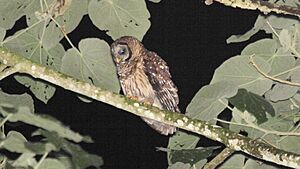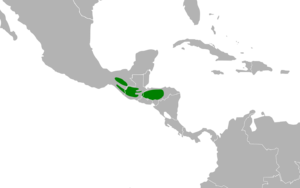Fulvous owl facts for kids
Quick facts for kids Fulvous owl |
|
|---|---|
 |
|
| Conservation status | |
| Scientific classification | |
| Genus: |
Strix
|
| Species: |
fulvescens
|
 |
|
The fulvous owl (also called the Guatemala barred owl) lives in the cloud forests of Central America. It's a medium-sized owl with a round head. Unlike some owls, it doesn't have ear tufts. Its feathers are usually warm dark brown or reddish-brown on its back. Its front is lighter brown with darker stripes.
Adults weigh about 600 grams (1.3 pounds). Female owls are usually heavier than males. You can find these owls in the mountains of Guatemala, Honduras, El Salvador, and parts of Mexico. They live high up, from about 1,200 to 3,100 meters (3,900 to 10,000 feet) above sea level. They are quite common where they live.
Scientists don't know much about how they behave. Their exact numbers and where they live are also a bit of a mystery. The International Union for Conservation of Nature says it's a species of "least concern." This means it's not currently in danger of disappearing. However, in Mexico, it is considered an endangered species.
Contents
About the Fulvous Owl
The fulvous owl is a single species in the Strix group of owls. This group belongs to the family of "true owls," called Strigidae. Scientists officially described the fulvous owl in 1868. The first owl studied came from Guatemala.
For a while, in 1970, some thought it was a type of barred owl. But today, most scientists agree it is its own separate species. Some researchers still think it's closely related to the barred owl and the spotted owl.
What Does It Look Like?
The fulvous owl is a medium-sized owl with a round head. It does not have the ear tufts that some other owls have. These owls are usually between 38 and 48.5 centimeters (15 to 19 inches) long. Their wings can be 30 to 33.3 centimeters (12 to 13 inches) long. Their tails are about 18.5 to 21 centimeters (7 to 8 inches) long.
The owl's face is a dull brownish-white or pale yellow-brown. It is a bit darker around its eyes. It has dark brown rings on its face and short white eyebrows. The top of its head and its back are a rich, warm dark brown or reddish-brown. Lighter marks cover its head and neck.
Its upper body has light brown stripes. Its wings have small pale brown spots. The main flight feathers have large spots that are whitish to pale brown. The feathers on its belly are light brown with dark brown or reddish-brown streaks. The owl's beak and the waxy part above it are yellowish. Its legs are covered in reddish-brown feathers down to its yellowish toes. Its eyes are dark brown.
Male and female fulvous owls look alike. Baby owls are whitish. Young owls are cinnamon-brown with yellowish or white stripes.
The fulvous owl looks most like the barred owl, which lives in Mexico, Canada, and the United States. However, the barred owl is grayer on top and whiter underneath. The fulvous owl is also about one-fifth smaller than the Mexican barred owl. Another owl, the mottled owl, lives in the same areas. But it is found at lower altitudes. It is also darker brown and smaller.
Where It Lives and Its Home
The fulvous owl lives in the mountains of the Mexican states of Chiapas and Oaxaca. It also lives in Guatemala, Honduras, and El Salvador. Scientists confirmed its presence in Oaxaca in 2011. Its full range is not well known, but it is thought to be large.
This owl lives in mountains at heights between 1,200 and 3,100 meters (3,900 to 10,000 feet). It prefers evergreen pine forests and humid pine-oak forests. It also lives in cloud forest habitats.
The International Union for Conservation of Nature (IUCN) believes there are between 20,000 and 50,000 fulvous owls. However, their numbers might be going down because they are losing their homes. Even so, the IUCN calls it a species of "least concern" because it has a large range and a good number of birds. In Mexico, the owl's population has dropped by half in the last century. This is why the Mexican government lists it as an endangered species.
Behavior and Life Cycle
The fulvous owl makes a loud, barking hoot. It sounds like "who-wuhu-woot-woot" or "a'hoo a'hoo-hoo a'hoo, hoo." The number of hoots can change. Some say its call sounds like Morse code. Female owls have a higher-pitched call. Sometimes, a male and female will hoot together.
These owls are nocturnal, meaning they are active at night. They hunt from a perch, waiting for prey. We don't know much about what they eat. They probably eat small animals like rodents, large insects, birds, frogs, and lizards. Scientists found large insects in the stomach of one owl they studied. One owl was seen trying to catch a highland guan. Feathers from a blue-throated motmot were found near an owl's nest.
The fulvous owl does not migrate. It stays in the same area all year. Not much is known about its behavior. Like most owls, it is thought to be monogamous, meaning it has one mate.
Young owls have been seen in May. The eggs hatch after 28 to 30 days. A female owl usually lays two or three eggs, but sometimes up to five. They usually build their nests in holes or hollows in trees. The female owl sits on the eggs to keep them warm. The male owl is thought to find food for the female and the young owlets.


